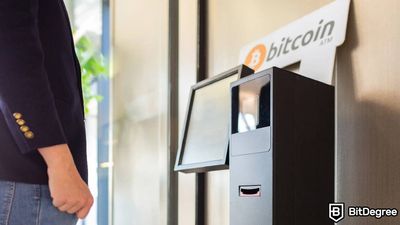Key Takeaways
- Grid trading bots provide traders with automated precision in executing buy and sell orders according to preset parameters;
- Spot grid trading bots are most effective in markets characterized by ranging or sideways price movements;
- Even though they offer trading automation, for best profitability, grid trading bot strategies and parameters should be continuously optimized to match the market changes.
Free Airdrop Season 7 is LIVE! Answer fun questions or do simple tasks to earn rewards from the $30K BitDegree prize pool. Participate Now ! 🔥
Automated grid trading bots are gaining immense popularity among investors and traders seeking a more efficient and disciplined approach. In today's fast-paced and dynamic financial landscape, traditional trading methods often struggle to keep up with market fluctuations and seize profitable opportunities.
Thus, I'll delve deep into the world of crypto grid trading bots, exploring their functionality, benefits, and strategies. So, follow up to discover the power of crypto grid trading bots and learn how to navigate bot trading with Binance, Bybit, and KuCoin.
By examining the unique features and trading environments offered by these platforms, you can equip yourself with the knowledge and tools necessary to harness the full potential even of forex grid trading bots. But first, let’s start with the basics.

Did you know?
Subscribe - We publish new crypto explainer videos every week!
What is BNB? The Truth Behind Binance Smart Chain (Animated)


Table of Contents
What is Grid Bot Trading?
Grid trading bots are among the most widely used strategies in the cryptocurrency world today. These trading tools operate based on predefined rules and parameters, executing trades within a grid-like structure on the trading chart.
Latest Deal Active Right Now:Head to BitDegree Missions, gather as many Bits as possible & claim your stake of the $30,000 Prize Pool! Don't waste your time & start collecting Bits by completing Missions and referring friends.
The concept behind grid trading is to take advantage of price volatility within a specific range, aiming to generate profits from the repetitive oscillations of prices. Grid bot trading works by dividing the price range into intervals or grids.
Traders set the upper and lower boundaries of the range they want to trade within, as well as the grid spacing.
For example, a trader may set a range of $10,000 to $12,000 for Bitcoin and choose a grid spacing of $200. In this way, the bot will place buy orders at every $200 increment within the specified range. Also, it will simultaneously place sell orders at the same intervals above the initial buy orders.
When the market price reaches one of the predetermined grid levels, the bot executes the corresponding buy or sell order. If the price moves up and hits a sell order, the bot sells a portion of the asset.
Conversely, if the price moves down and hits a buy order, the bot buys more of the asset. This process continues as the price fluctuates within the defined range. The objective of grid bot trading is to capture profits from the price movement between the buy and sell orders.
So, when the price moves up, the bot sells at a higher price, generating a profit. Similarly, when the price moves down, the bot buys at a lower price, also generating a profit. By repeatedly buying low and selling high within the grid, traders aim to accumulate profits over time.

A grid trading bot can be applied to various trading pairs and timeframes, depending on the trader's preferences and market conditions. Moreover, it is commonly used in range-bound or sideways markets, where prices are not experiencing strong trends and instead move within a specific range.
In such market conditions, grid trading can be an effective strategy to exploit price fluctuations and generate consistent profits. Traders have the flexibility to customize the parameters of their grid trading bot. They can adjust the range width, grid spacing, and the number of grids to suit their trading goals and risk tolerance.
Additionally, some bots offer additional features such as stop-loss orders to manage risk and take-profit targets to secure profits. Overall, grid bot trading provides traders with an automated approach to capitalize on price volatility within a predefined range.
By using predefined rules and parameters, traders can execute trades without constant manual intervention and take advantage of repetitive price movements. However, it is essential for traders to carefully consider market conditions and set appropriate parameters to optimize the performance of their trading bots. Overall, trading bots do not guarantee success, so you have to be cautious.
That said, let's dive deeper into the world of grid trading, focusing our attention on the various types of trading bots available.
Types of Grid Trading Bots
For starters, let's get one thing clear – there are two main markets in which grid trading bots participate: spot and forex.
Spot grid trading bots operate on cryptocurrency exchanges (and I'll mostly talk about these bots in this article). They execute trades at predetermined price levels, creating a grid pattern. By buying low and selling high within a specified range, a spot grid trading bot automates profit generation. Traders must monitor market conditions and adjust strategies to mitigate potential losses.
Forex grid trading bots, on the other hand, operate in the foreign exchange market. They place buy and sell orders at predetermined price levels to capture profits within a specified range. These bots operate 24/7, monitoring multiple currency pairs and executing trades based on the predefined grid strategy. Risk management is crucial, considering market volatility and fundamental news events.
Spot grid trading bots and forex grid trading bots are very distinct from each other. The main point is that spot grid trading bots excel in cryptocurrency exchanges, while a forex grid trading bot thrives in the foreign exchange market. Understanding their characteristics allows traders to implement grid trading strategies effectively.
However, while these trading bots may be different, they can be distinguished into three major categories of trading bots: rule-based and AI-powered.
Rule-Based
Rule-based trading bots are the traditional and widely used type of bots. They operate based on predefined rules and parameters set by the trader. The trader determines the price range in which they want the bot to operate and sets the grid spacing, which determines the distance between buy and sell orders.
With rule-based bots, traders have control over the specific rules that govern the bot's trading behavior. They can customize parameters such as the grid spacing, the number of grid levels, the buy and sell order sizes, and other variables.
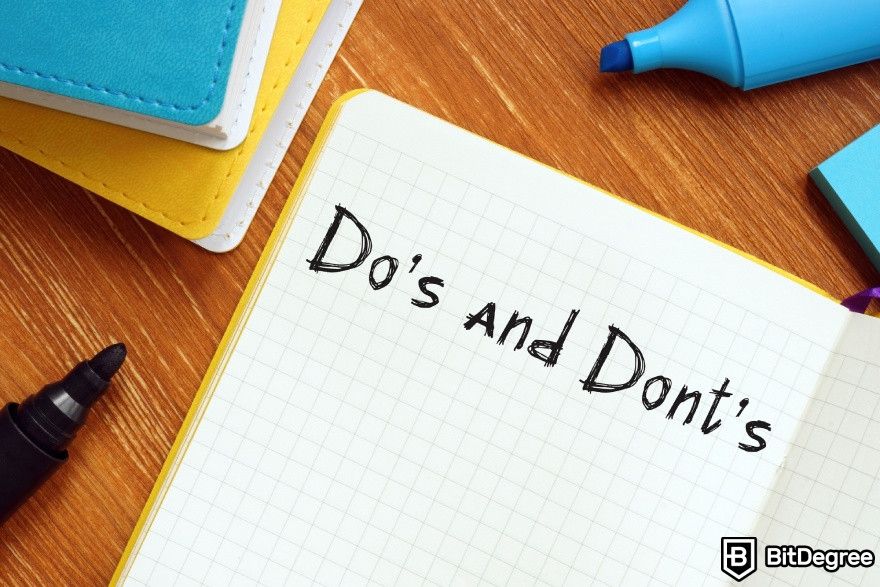
These bots follow the predetermined rules and execute trades automatically when the market price reaches certain levels within the defined grid. Rule-based bots are relatively simple to set up and understand, making them accessible to traders with varying levels of experience.
Moreover, traders can adjust the parameters to align with their trading strategies and risk tolerance. They offer a systematic approach to grid trading and allow for precise control over trade execution.
AI-Powered
In contrast, AI-powered bots leverage artificial intelligence and machine learning algorithms to enhance trading strategies[1]. These bots analyze vast amounts of historical and real-time market data, identify patterns, and learn from market conditions to make informed trading decisions.
AI-powered bots can adapt to changing market dynamics. They can automatically adjust their grid parameters, such as the grid spacing, range width, and even the number of grid levels, based on real-time market trends and volatility.
As a result, these bots continuously learn and improve their trading strategies based on new data and market insights. The advantage of AI-powered bots lies in their ability to handle complex and dynamic market conditions.

They can identify optimal entry and exit points more accurately, adapt to different market phases (ranging or trending), and potentially generate higher returns compared to rule-based bots. However, it's important to note that AI-powered bots may require more advanced technical skills to set up and optimize.
Traders need to consider factors such as data quality, algorithm training, and model accuracy when using AI-powered bots.
All in all, rule-based bots offer simplicity and customization, while AI-powered bots provide adaptability and advanced analytical capabilities. The best part about this is that traders have the freedom to choose the type of bot that best aligns with their trading style, goals, and technical expertise, leading to a more optimized trading experience.
Pros and Cons of Grid Trading Bots
Now that you know what kind of grid trading bots there are, it’s worth noting that while they offer benefits to traders, they also come with certain drawbacks. So, let’s look into both.
Pros
- Taking Advantage of Price Swings. Grid trading bots excel in range-bound or sideways markets, where prices fluctuate within a defined range. These bots can take advantage of price oscillations by placing buy and sell orders at regular intervals within the predetermined range. As the price moves up and down, the bot can potentially capture multiple small profits from each trade executed within the grid.
- Trading Automation. Grid trading bots (or any other type of bots) execute trades automatically. So, traders can set up their strategies and let the bot handle the trading process 24/7, without the need for constant monitoring. This automation eliminates the influence of emotions and ensures that trades are executed promptly and consistently according to the established parameters.
- Diversification and Risk Management. Grid trading bots can be configured to operate on multiple trading pairs simultaneously, allowing traders to diversify their portfolios and spread the risk across different assets. By using multiple grids on various trading pairs, traders can potentially reduce their exposure to a single asset and mitigate the impact of adverse price movements.
Cons
- Mostly Suitable for Range-Bound Markets. While grid trading bots perform well in range-bound markets, they can struggle in trending markets where prices consistently move in one direction. In such scenarios, the bot's buy and sell orders may get trapped on one side of the market, resulting in missed trading opportunities or potential losses.
- Can Be Affected by Whipsaw Movements and False Breakouts. Whipsaw refers to rapid and unexpected price movements that can trigger buy or sell orders before quickly reversing direction. Similarly, false breakouts occur when the price briefly breaks through the defined range but then retreats into the range. These situations can lead to multiple trades being executed at unfavorable prices and may erode profits or increase losses.
- Has a Steeper Learning Curve. Configuring grid parameters requires careful consideration and optimization, so it's not a suitable trading tool for a complete newbie. You need to know how to determine the appropriate grid spacing, range width, and other parameters to ensure the bot performs effectively. Besides, market conditions are not static, so you need to regularly evaluate and adjust the grid parameters to align with changing market dynamics.
So, now that you know all the essential information about grid trading bots, you might be wondering where to find a reliable trading bot. Let me help you with that!
Best Grid Trading Bots Available
In recent years, the use of grid trading bots has revolutionized the crypto market. Among the various strategies and tools available, efficient trading bots have emerged as a popular choice due to their ability to capitalize on market volatility and generate consistent profits.
These bots have gained traction among cryptocurrency enthusiasts, offering a systematic and automated approach to trading on popular exchanges like Binance, KuCoin, Bybit, and HTX (previously Huobi). So, let's explore some of the best grid trading bots available on the aforementioned cryptocurrency exchanges:
Binance
The Binance grid trading bot is an automated tool designed to help you capitalize on market fluctuations on the Binance exchange. There are two types of Binance grid trading bots – spot and futures.
The spot grid bot, as the name suggests, is made for the spot market. It works great in volatile markets and has preset ranges. The futures grid bot, on the other hand, allows you to capture volatility in the futures market. It supports neutral, long, and short approaches with leverage.
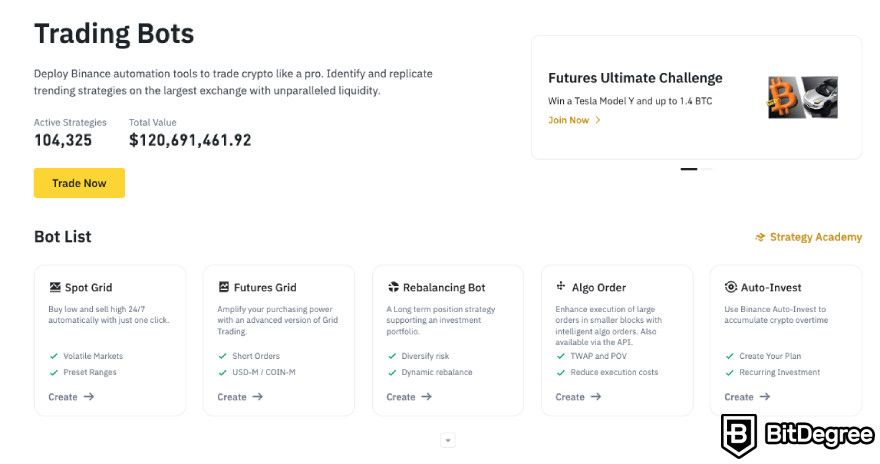
Besides, you can create your own grid trading strategies on Binance or copy existing ones from the Strategy Pool. Thus, Binance grid trading bots are pretty easy to use for both beginners and experienced traders.
The best part, however, is that all Binance trading bots are free; you only need to cover the usual trading fees.
KuCoin
KuCoin, another prominent cryptocurrency exchange, also provides users with some of the best grid trading bots. Like Binance, it offers spot and futures grid bots. The former is for selling high and buying low, while the latter is for long or short strategies on the futures market.
Though, apart from these two, KuCoin also provides users with the infinity grid bot, which essentially is a more flexible version of the spot grid trading bot that's best to use during bull markets.
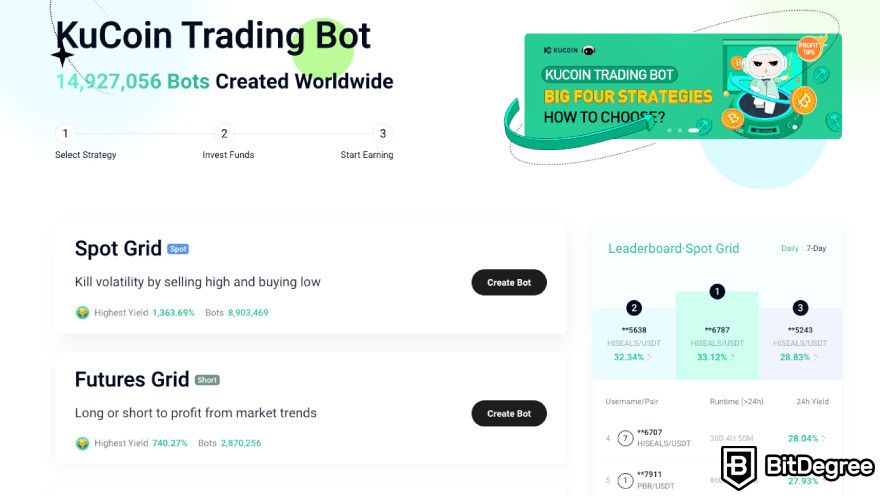
Infinity grid trading is an advanced grid trading strategy that solves the problem of missed opportunities when prices rise too high. The infinity grid bot helps you buy low and sell high consistently while keeping the value of your digital assets stable in a growing market.
Overall, KuCoin’s bots come with a user-friendly interface. Besides, the exchange’s robust security measures and competitive trading fees further enhance the appeal of its crypto grid trading bots, ensuring a reliable and efficient trading experience. Plus, the bots are completely free to use.

Did you know?
Subscribe - We publish new crypto explainer videos every week!
Candlesticks, Trendlines & Patterns Easily Explained (Animated Examples)


Bybit
Bybit, a popular derivatives exchange known for its advanced trading features, offers trading bots tailored to its platform as well. With Bybit's perpetual contracts and leverage options, its trading bots enable users to take advantage of margin trading opportunities while implementing grid strategies.
Bybit's futures grid trading bot supports up to 100x leverage and is fit for any market condition. Bybit's spot grid trading bot, on the other hand, is great for sideways markets.
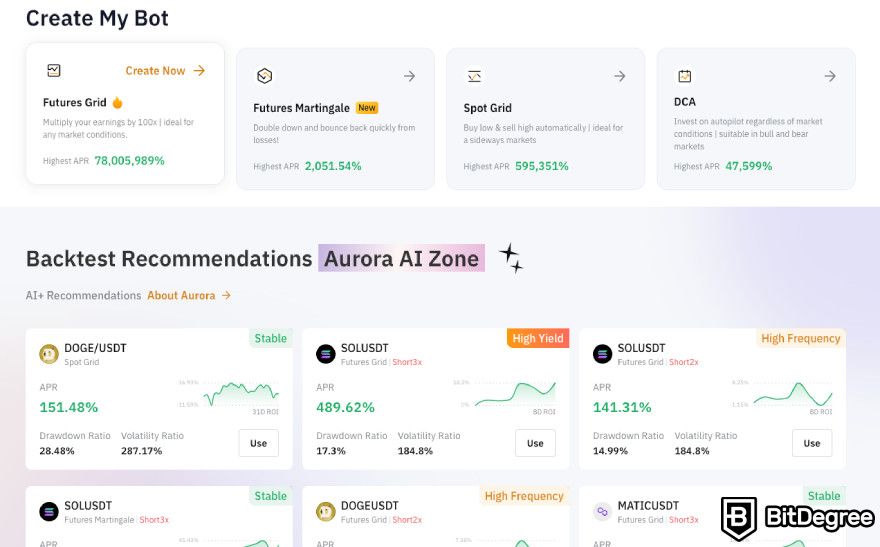
Again, like with Binance and KuCoin, there are no additional fees for Bybit bots, apart from the usual ones charged for spot or futures trading.
By the way, Bybit provides users with Aurora AI, which generates 18 sets of trading bot strategy recommendations based on your trading needs. Hence, it simplifies bot trading for everyone (even complete newbies).
All in all, grid trading bots have surely emerged as powerful tools for automating and optimizing trading activities on popular cryptocurrency exchanges. That said, find more trading bots here.
How to Use Grid Trading Bots?
Now that you know what grid trading bots are and which ones are the best, you might be wondering how to use them. While there are different variations of these bots, they typically involve the same practices. So, let’s look over them.
Step 1: Grid Setup
The grid setup involves defining the price levels at which the bot will place buy and sell orders. These price levels are usually determined based on market analysis, including support and resistance levels, or other technical indicators. Traders can choose the spacing between the price levels based on their desired risk-reward ratio and current market conditions.
Step 2: Order Placement
Once the grid is set up, the bot automatically places buy orders at the lower price levels and sell orders at the higher price levels. These orders are typically limit orders.
This means they are executed only when the market reaches the specified price level. By placing orders at multiple price levels, the bot aims to capture potential price movements and profit from them.
Step 3: Position Management
As the market moves, the bot adjusts its buy and sell orders to reflect the changing price levels. For example, if the price increases and a sell order is executed, the bot will reposition the corresponding buy order at a higher price level.

Similarly, if the price decreases and a buy order is executed, the bot will reposition the corresponding sell order at a lower price level. This continuous adjustment allows the bot to adapt to market fluctuations and potentially generate profits from both upward and downward price movements.
Step 4: Hedging
Grid bots often incorporate hedging techniques to manage risk. Hedging involves opening opposite positions to offset potential losses. For example, if the bot has a buy order executed, it may open a sell order as a hedge to limit potential losses in case the market moves against the initial position.
Step 5: Take Profit and Stop Loss
Grid bots typically include predefined take profit and stop loss levels for each position. The take profit level represents the desired profit target at which the bot will close the position to secure profits.
Conversely, the stop loss level represents the maximum acceptable loss at which the bot will close the position to limit losses. These levels are determined based on the trader's risk appetite and strategy. By implementing it, the bot aims to maintain a disciplined approach to risk management and prevent excessive losses.
Step 6: Risk Management
Proper risk management is crucial when using trading bots. Traders should consider factors such as position sizing, capital allocation, and overall exposure.
Position sizing refers to determining the appropriate size of each grid order based on the trader's risk tolerance and account balance. In addition, capital allocation involves allocating a portion of the trading capital to the grid strategy while diversifying the remaining capital across other strategies or investments.

Furthermore, monitoring and adjusting the bot's parameters regularly is important to adapt to changing market conditions and ensure that potential losses are controlled and within acceptable limits. Traders should also consider backtesting the bot's performance before deploying it in live trading.
By following these practices, traders can utilize grid bots to automate their trading strategies, potentially benefit from market volatility, and effectively manage risk.
Now, with a solid understanding of the practices involved in using these bots, we should also talk about the best grid trading bot strategies aimed at optimizing the performance of these automated tools.

- Secure and reliable
- Accepts fiat currencies
- Lots of trading options
- Reputable exchange
- Accepts fiat currencies
- Offers various trading options

- Fiat currencies - accepted
- Simple to use
- Accepts only the most trustworthy cryptocurrencies
- A leading cryptocurrency exchange platform
- Best for beginner investors
- Accepts fiat currencies

- Fully reserved and transparent
- Multiple tradable asset classes
- Over 300 supported cryptos
- Over 300 cryptocurrencies
- Secure & transparent
- Fully reserved
Grid Trading Bot Optimization
As grid trading bots continue to gain popularity among traders, it becomes imperative to explore strategies for optimizing their performance. So, let’s delve into various approaches and techniques that can be employed to enhance their profitability, adaptability, and risk management capabilities.
Parameter Optimization
A critical aspect of optimizing a grid trading bot is fine-tuning the parameters that govern its behavior. Traders need to carefully analyze and test different parameter values specific to their grid trading bot strategy, including the grid spacing, the number of grid levels, and the size of each grid order.
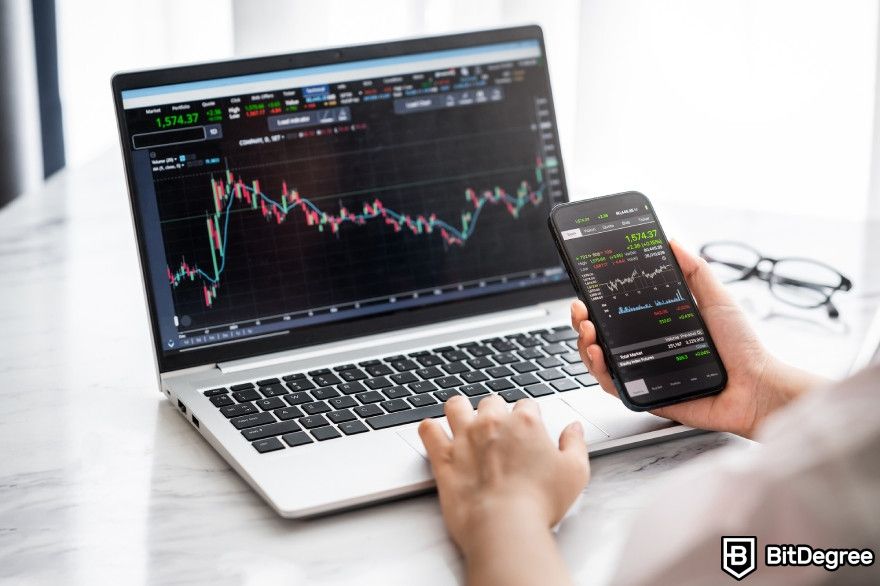
By backtesting these parameters with historical data and evaluating their performance under different market conditions, traders can identify and focus on optimal values. Those that align with their risk appetite and maximize profitability within their strategy.
Additionally, by implementing adaptive mechanisms, such as dynamically adjusting these parameters based on market volatility, traders can further enhance the bot's performance, maximizing their profits even more and minimizing their losses.
Dynamic Grids
While static grids provide a structured approach to trading, they may not fully capture the market's evolving dynamics. To address this limitation, traders can explore dynamic grid strategies. This approach involves adjusting the grid levels and spacing based on market conditions, such as volatility or trend strength.
By dynamically adapting the grid, the bot can align itself with the current market environment, potentially capturing more profit opportunities and reducing risks during periods of heightened volatility or trending markets. Incorporating dynamic grid strategies can enhance its ability to adapt to changing market conditions.
Trend Filtering
Integrating trend-filtering techniques can significantly enhance the performance of trading bots. By analyzing price patterns, moving averages, or other trend indicators, traders can determine the overall market direction.
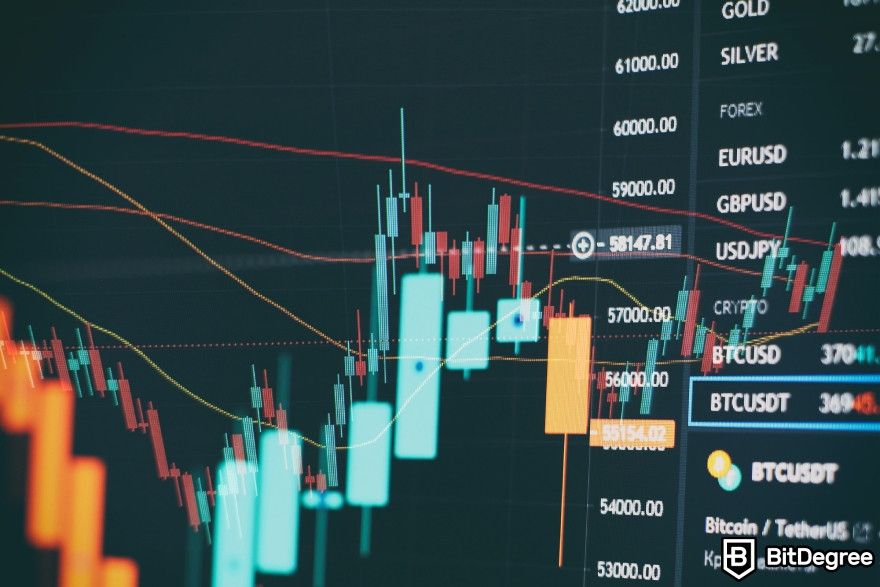
During trending markets, the bot can adjust the grid orientation or temporarily disable trading to avoid being caught in prolonged adverse price movements. Conversely, during range-bound markets, the bot can focus on exploiting price oscillations within the established grid.
By incorporating trend analysis, traders can adapt their bot's behavior to align with the prevailing market conditions and optimize its grid trading bot strategy accordingly.
Risk Management Enhancements
Effective risk management is crucial for long-term success. Traders can enhance their bot's risk management techniques to mitigate potential losses and protect their capital.
Strategies such as implementing trailing stop losses and dynamically adjusting position sizes based on market conditions can help manage risk more effectively. However, even incorporating a maximum exposure limit can prove beneficial.
By optimizing take-profit levels based on historical data or volatility analysis, traders can secure profits at optimal points while maintaining a favorable risk-reward ratio. If they continuously evaluate and improve risk management techniques, traders can safeguard their bot's performance in various market scenarios.
Fundamental Analysis Integration
While a grid trading bot is primarily driven by technical analysis, integrating fundamental analysis can provide valuable insights, too. It involves evaluating the intrinsic value of crypto by examining factors like technology, project team, use case, adoption, and market demand.
Unlike technical analysis, which focuses on price movements, fundamental analysis assesses the long-term potential and investment value of cryptocurrencies based on their underlying fundamentals (you can find some of that information on the BitDegree crypto tracker).
![]()
By aligning fundamental factors with technical signals, traders can optimize their bot's decision-making process and improve its ability to respond to market-changing events. However, it's important to strike a balance between technical and fundamental analysis, ensuring that the bot's core grid trading strategy remains intact.
Speaking of the types of analysis, traders should also consider implementing sentiment analysis and backtracking of historical data[2].
Diversification and Correlation Analysis
Expanding the scope of grid trading by diversifying across multiple instruments or markets can enhance the bot's performance and reduce overall risk. Traders should consider implementing correlation analysis to select assets with low or negative correlations, reducing the likelihood of simultaneous drawdowns.
Additionally, by incorporating asset allocation strategies and balancing exposure across different market sectors or geographic regions, traders can provide further risk mitigation and potential profit diversification. By diversifying their bot's trading portfolio, traders can increase the bot's adaptability to various market conditions and reduce vulnerability to specific asset classes or sectors.
Overall, optimizing these bots requires a systematic and iterative approach. By fine-tuning parameters, embracing dynamic grid strategies, and incorporating trend filtering and risk management enhancements, traders can unlock the full potential of their trading bots and elevate their grid trading bot strategy to new heights.
Conclusions
To sum up, a grid trading bot offers traders an automated approach to capitalize on price volatility within a defined range. Bots like these can provide various benefits, including potential profits in range-bound markets, automation of the trading process, and diversification with risk management features.
However, traders must also navigate challenges related to trending markets and whipsaw movements and learn how to optimize parameters effectively.
By understanding these benefits and challenges, they can make informed decisions and effectively leverage crypto grid trading bots on platforms like Binance, Kraken, and KuCoin, or even forex grid trading bots on the forex market.
The content published on this website is not aimed to give any kind of financial, investment, trading, or any other form of advice. BitDegree.org does not endorse or suggest you to buy, sell or hold any kind of cryptocurrency. Before making financial investment decisions, do consult your financial advisor.
Scientific References
1. M. B. Chenguel: 'The Nexus Between Blockchain, Crypto Currencies and AI: With Case Study';
2. A. S. Murthy, A. Akshay, B. R. Hanji: 'Cryptocurrency Trading Bot with Sentimental Analysis and Backtracking Using Predictive ML'.






